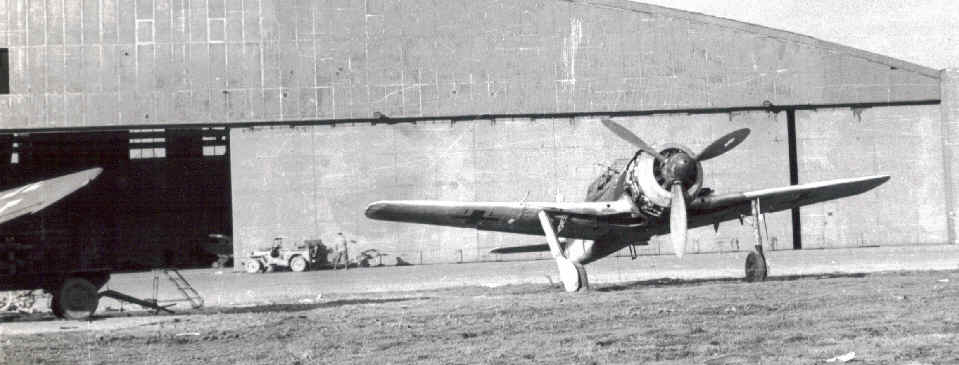
Image du Jours -- World War II
About this Fw-190 -- WWII #14 of 23.

(Image from Stockum-Cashion Collection)
Faber's Amazing Mission
Now is a different view of the base. Of the three hangars, there has been the one with the wind-sock by the "tower," which is to the far right. That was the one with the group of planes that comprised the aircraft in the last three photos.
And in the first two images of this WWII series, there have been images of the aircraft just inside another hangar. I believe that one to be the middle of the three.
And now this one, which I think is the left end of the hangars -- and in front of it is this very interesting Fw-190.
The pilots' response to seeing this aircraft for the first time would have been obvious after he had been driving an Me-109 around an airfield. The wide stance of the Fw-190 promised good ground control.
Though this aircraft is not in immediate flyable condition, it certainly looks to be in better shape than some that were selected for destruction. I don't know why this one was left in this condition. (Did they run out of time?) Or maybe they knew something about the plane we wouldn't.
It is obvious that this fighter has a modified canopy -- it has been extended, not unlike the tandem Me-109G1/G12 seen earlier.
My Profile on the Fw-190A tells me a lot. For instance, this is an Fw-190A-8/U1, a two-seat trainer, of which two (some reports say three) prototypes were made, and only one production model, of which there were very few. Officially, it was the Fw-190S for "Schulflugzeug" -- flight training plane.
This modification was particularly to retrain pilots transitioning from Stukas to the Fw-190. The aft controls were simplified -- all trim functions, landing gear controls, and the like remained an exclusively front cockpit operation. There were only airspeed, turn/bank indicator, and altimeter for the aft pilot, no doubt the instructor.
To the left in this image is the wing tip of a German aircraft not shown before but there will be more of it later.
A GI with the US jeep is near the hangar door and just inside the hangar is a high-wing observation plane which I haven't been able to identify -- it is not a Storch -- I can recognize them even if only a small piece is seen.
The Germans had nothing that looked like our observation planes and yet, that is what this one looks like. I guess it would have been possible for some intelligence personnel to have arrived in one but that seems a little presumptuous for this recognition effort.
I have scanned all of these photos with good optical equipment and I have located some interesting things here and there but this is almost like finding familiar shapes in clouds; I will not comment on these.
This is a short text so I will tell a favorite Fw-190 story.
On June 23, 1942, Staffels 7/JG2 and 3/JG2 in Fw-190s, were in some pretty intense aerial combat with Spitfires from Exeter. JG2 was the "Richthofen" group and had some of the best German fighter pilots. The adjutant of Staffel 3/JG2, Oberleutenant Arnim Faber, was flying one of the Fw-190s. This combat in an area 40 miles NE of Plymouth – both Plymouth and Exeter are in Devonshire and towards the SW tip of England. (These directions and distances are important.)
During the late afternoon of that day, RAF personnel at Pembrey flying station, near the mid-south coast of Wales, 60 miles NNW of Exeter, were surprised to see a single Fw-190 come over the field. And then, behold, the landing gear went down and it LANDED!
It was flown by the JG2 adjutant, Arnim Faber. He never said why he landed, though to his death, he talked about a faltering engine, shaking controls, and the like.
At this time, this JG2 squadron was flying out of France and the layout of that field was similar to the one at Pembrey, Wales.
If someone intending to fly from Exeter back to JG2 base in France, had flown exactly 180 degrees to that preferred course, he would flown over Pembrey. It happens that Pembrey was the same distance from the channel coastline as was JG2's base in France -- only in this case, it would be the coastline of the Bristol Channel, not the coastline of the English Channel. The channels are similar widths on this heading.
Could Faber have actually landed in Pembrey, Wales, thinking he was back at his base in France?
Apparently so.
Was he really having trouble flying the Fw-190?
I don't think so. Otherwise, he would not have buzzed the field and then pulled up into a series of sharp victory rolls before landing his like-new, pristine, boldly-painted Fw-190A-3.
Ken Cashion